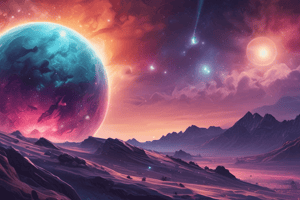Podcast
Questions and Answers
Stars are celestial bodies that radiate energy derived from thermonuclear reactions occurring in their ______
Stars are celestial bodies that radiate energy derived from thermonuclear reactions occurring in their ______
cores
Stars are massive, hot spheres of plasma, primarily composed of ______ and helium
Stars are massive, hot spheres of plasma, primarily composed of ______ and helium
hydrogen
Stars are not only found in our Milky Way galaxy but also in billions of other galaxies throughout the ______
Stars are not only found in our Milky Way galaxy but also in billions of other galaxies throughout the ______
universe
Stars form within large clouds of gas and dust, known as molecular clouds, which can contain up to one ______ stars
Stars form within large clouds of gas and dust, known as molecular clouds, which can contain up to one ______ stars
The process begins with gravity causing the molecular cloud to collapse, leading to the development of a protostar or 'baby ______'
The process begins with gravity causing the molecular cloud to collapse, leading to the development of a protostar or 'baby ______'
The longest phase in a star's life cycle is the main sequence stage, during which the star generates energy through nuclear ______
The longest phase in a star's life cycle is the main sequence stage, during which the star generates energy through nuclear ______
Lower-mass stars burn fuel more slowly and for longer periods of time due to their ______
Lower-mass stars burn fuel more slowly and for longer periods of time due to their ______
At the end of their lives, low-mass stars like our Sun will eventually become subgiants or giants, with their outer layers ejected to form a planetary ______
At the end of their lives, low-mass stars like our Sun will eventually become subgiants or giants, with their outer layers ejected to form a planetary ______
More massive stars undergo a supernova explosion, resulting in the formation of either a neutron star or a ______ hole
More massive stars undergo a supernova explosion, resulting in the formation of either a neutron star or a ______ hole
Stars are composed primarily of hydrogen and ______
Stars are composed primarily of hydrogen and ______
Study Notes
Stars are celestial bodies that radiate energy derived from thermonuclear reactions occurring in their cores. They are massive, hot spheres of plasma, primarily composed of hydrogen and helium. Stars are not only found in our Milky Way galaxy but also in billions of other galaxies throughout the universe.
Stars form within large clouds of gas and dust, known as molecular clouds, which can contain up to one septillion stars. The process begins with gravity causing the molecular cloud to collapse, leading to the development of a protostar or "baby star." This occurs when the collapsing cloud heats up due to friction, eventually leading to the formation of a protostar.
Once formed, stars undergo various stages in their life cycles. The longest phase is the main sequence stage, during which the star generates energy through nuclear fusion, converting hydrogen into helium. The star's luminosity, size, and temperature change gradually over millions or billions of years, with lower-mass stars burning fuel more slowly and for longer periods of time.
At the end of their lives, stars undergo different types of deaths depending on their mass. Low-mass stars, like our Sun, will eventually become subgiants or giants, with their outer layers ejected to form a planetary nebula, leaving behind a white dwarf. More massive stars, on the other hand, undergo a supernova explosion, resulting in the formation of either a neutron star or a black hole.
The leftover material from the star's birth is used to create planets and other objects that orbit the central star. Observing star formation is challenging due to the presence of dust, which obscures visible light, but it can be studied using radio waves, which travel freely through space.
Stars are named based on their spectral type and brightness, and their classification is determined by their mass and spectral characteristics. The study of stars is a key area of research in astronomy, providing valuable insights into the formation, evolution, and ultimate fate of galaxies and the universe as a whole.
Studying That Suits You
Use AI to generate personalized quizzes and flashcards to suit your learning preferences.
Description
Explore the process of how stars form within molecular clouds, evolve through different stages in their life cycles, and meet their ultimate fates based on their mass. Learn about the diverse paths stars take, from becoming white dwarfs to undergoing supernova explosions and forming neutron stars or black holes.




